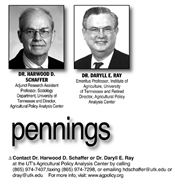|
Grocery Stores Require Complex Sanitation Practices To Help Protect Customers And Grocery Personnel From COVID-19

When we wrote our column two weeks ago on the availability of food during the COVID-19 outbreak (https://tinyurl.com/vp4kplw), we had no idea that column would be the first in a series of columns on the impact of the coronavirus on food and agricultural systems. Last week, as a follow up to the first column, we examined the challenges the disease is having on agricultural systems from obtaining field labor to keeping processing plants open (https://tinyurl.com/qwaaoow).
This week, we focus on the final step in getting food products from the field to the table: grocery shopping. Unlike some necessities such as electricity and water, which are delivered to our homes via wires and pipes, most of us get our food by making a trip to the local grocery store where we interact with store workers and other shoppers. Given that situation and the classification of grocery stores as one of the Critical Infrastructure Industries, we decided to make grocery store disease/food safety for workers and consumers the focus of this column.
While some experts believe that the peaking of the COVID-19 illness and the spread of SARS-CoV-2, the virus that causes the disease COVID-19, to reach an endpoint very quickly, our understanding of the literature and public statements of scientists working in this area suggests that we may see as many as three peaks, each one lower than the last, over a period of 12-18 months. If that repeated cresting turns out to be true, grocers, grocery personnel, and consumers are in for a long slog. To safely and effectively get through that time, grocers need to develop practices that will keep workers and consumers as safe as possible from contracting the disease.
Both customers and grocery store staff have the potential to be asymptomatic carriers of the virus who can deposit it on various surfaces. This unintended contamination leaves people who do not have the virus at risk of picking it up from the air or surfaces.
The most effective practice customers and staff can implement to protect themselves from the airborne spread of the virus is to practice social distancing. When possible, people should try to maintain a 6-foot distance between themselves and others in the grocery store.
The checkout lane is where keeping that distance is the most difficult. Customers and register clerks are usually about 3 to 4 feet apart. By installing protective barriers, such as the ones seen in pictures of European grocery stores, the problem of distancing at that location in the store can be abated. Additionally, bagging groceries should be carried out by one bagger or the customer, but not both. Doing so may seem awkward at first, but we believe customers understand the importance of social distancing.
Every area of the store presents some risk that must be evaluated and prioritized. We have identified the following risk areas:
• Grocery carts and baskets,
• All door handles that are touched by customers (coolers and freezers in particular),
• Grocery items that have been touched by other customers, register clerks, baggers, and anyone in the stocking and transportation system (virtually every item in the store),
• Payment pads, cash registers and the intercom system,
• Register conveyor belts and items used for bagging,
• Shelving and all display cases that customers can pick up items from and put in their carts, and
• Break rooms and eating areas for staff members.
In addition to social distancing, grocery stores can implement sanitization practices that have been scientifically validated to provide a “kill step” for the virus. These five issues need to be taken into consideration when sanitizing:
• The nature of the surface being sanitized,
• The lifespan of the virus on that surface,
• The selection and proper concentration of the sanitizing agent,
• The period of time needed to kill the virus on that surface, and
• The frequency of sanitation
To provide guidance in addressing these issues, we have identified four helpful documents.
On Tuesday, March 17, 2020, the National Institutes of Health posted a news release titled “New corona virus stable for hours on surfaces” (https://tinyurl.com/r9xvqp8). This release was based on a “Correspondence” by van Doremalen ,et al. titled “Aerosol and Surface Stability of SARS-CoV-2 as Compared with SARS-CoV-1” that was published in the New England Journal of Medicine (https://tinyurl.com/st62qy2.). For instance, the study found that “SARS-CoV-2 was more stable on plastic and stainless steel than on copper and cardboard, and viable virus was detected up to 72 hours after application to these surfaces…although the virus titer was greatly reduced from 103.7 to 100.6 TCID50 [50-percent tissue culture infective dose] per milliliter of medium after 72 hours on plastic and from 103.7 to 100.6 TCID50 per milliliter after 48 hours on stainless steel). On copper, no viable SARS-CoV-2 was measured after 4 hours…. On cardboard, no viable SARS-CoV-2 was measured after 24 hours.”
On its website, the Environmental Protection Agency provides information on cleaners and contact time needed to kill the SARS-CoV-2 virus, “List N: Disinfectants for Use Against SARS-CoV-2” (https://tinyurl.com/uf5kbyc). This list is most useful to grocery safety personnel while the Centers for Disease Control and Prevention offers guidance for “Cleaning and Disinfection for Households” (https://tinyurl.com/vhkmj4d).
As we learn more about this disease, guidance provided by scientists and government agencies will likely change.
We recommend that each grocery store establish a health and safety team to implement the guidance provided by corporate or association officials dealing with this pandemic outbreak. Given the complexity of this disease outbreak, fulltime personnel will need to be dedicated to sanitization tasks to provide workers and consumers with the level of safety they need and deserve. ∆
DR. HARWOOD D. SCHAFFER: Adjunct Research Assistant Professor, Sociology Department, University of Tennessee and Director, Agricultural Policy Analysis Center
DR. DARYLL E. RAY: Emeritus Professor, Institute of Agriculture, University of Tennessee and Retired Director, Agricultural Policy Analysis Center
|
|